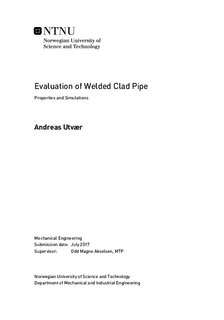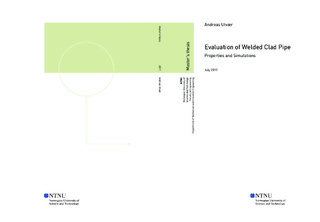| dc.description.abstract | Pipelines are an essential part of the oil and gas offshore industry, for transporting unprocessed oil and gas from the seabed to the oil platform and to the mainland. The unprocessed oil and gas leaves a corrosive environment, which sets a demand for pipes with a corrosion resistant interior. Clad pipes meet this demand with a corrosion resistant, stainless steel interior and an outer carbon steel layer. There is of today no repair contingency for clad pipes. A knowledge basis needs to be established and the risk of hydrogen induced stress cracking (HISC) must be found.
This thesis work has been divided into two parts; One part working on experimentally testing of the triple point in welded clad pipes. Focused on fracture resistance curves, fracture toughness and crack path, with and without hydrogen present. The second part was focused on modelling a FE-model that was able to simulate crack propagation in clad pipe interface samples, experimentally tested by Jemblie. Both with and without hydrogen present during testing.
Fracture mechanical testing of welded clad pipe C(T) samples have been successfully conducted, in air and under cathodic protection (CP). The samples with Ni-interlayer showed almost no reduction in fracture toughness from tests in air to tests under CP, with an average fracture toughness reduction of 0.13%. The small fracture toughness reduction may be explained by the crack path going into the Ni-interlayer which is not much susceptible to hydrogen embrittlement (HE). The samples without Ni-interlayer experienced a high decrease in fracture toughness tested under CP, with an average reduction in fracture toughness equal to 92%. The crack path in the samples without Ni-interlayer was examined in a light optical microscope (LOM). The test done in air showed a crack path shifting between the base material and the clad. The crack propagated mainly in the clad in the sample tested under CP. Not enough samples were tested to establish the fracture resistance curves for the samples without Ni-interlayer. A 2D FE-model with cohesive zone elements was successfully modelled. The FE-model was able to simulate crack propagation along the crack ligament, in a C(T) specimen, both with linear elastic and elastic-plastic materials. The FE-model was however not able to simulate the crack propagation observed in experimentally testing by Jemblie. This was not possible due to numerical problems occurring after a few cohesive elements had failed, when using sufficiently high cohesive element parameter values.
For further work should more tests in both air and under CP be done on welded samples, with and without a Ni-interlayer. To establish the fracture resistance curves for both sample types. The microstructure on the samples without Ni-interlayer needs to be checked, to be sure that the samples are representative for welded clad pipes. The fractography must be studied and the cross section on multiply samples must be examined, on the samples without Ni-interlayer. To establish a more solid basis to explain the crack path and the hydrogen susceptibility on welded clad pipes. A deep root-cause investigation should be done on the FE-simulation, to explain and come up with a possible solution on the numerical crack propagation problem. | |

